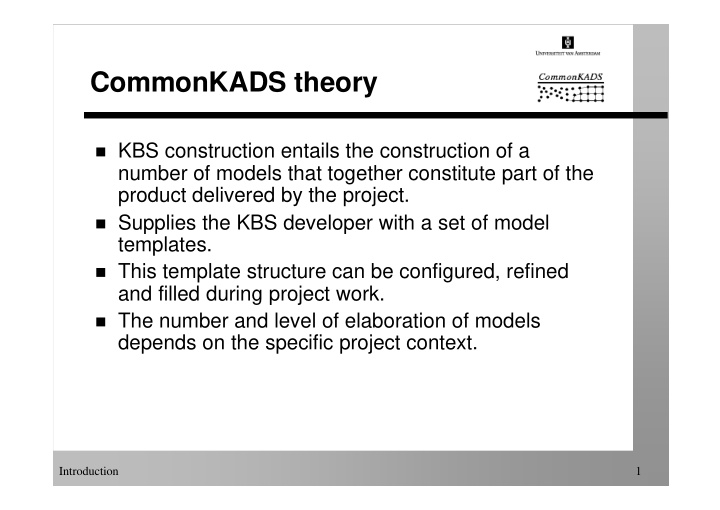



CommonKADS theory � KBS construction entails the construction of a number of models that together constitute part of the product delivered by the project. � Supplies the KBS developer with a set of model templates. � This template structure can be configured, refined and filled during project work. � The number and level of elaboration of models depends on the specific project context. Introduction 1
CommonKADS Model Set Organization Task Agent Context Model Model Model Knowledge Communication Concept Model Model Design Artefact Model Introduction 2
Model Set Overview (1) Organization model � supports analysis of an organization, � Goal: discover problems, opportunities and possible � impacts of KBS development. Task model � describes tasks that are performed or will be performed in � the organizational environment Agent model � describes capabilities, norms, preferences and permissions � of agents (agent = executor of task). Introduction 3
Model Set Overview (2) � Knowledge model � gives an implementation-independent description of knowledge involved in a task. � Communication model � models the communicative transactions between agents. � Design model � describes the structure of the system that needs to be constructed. Introduction 4
Principles of the Model Set � Divide and conquer. � Configuration of an adequate model set for a specific application. � Models evolve through well defined states. � The model set supports project management. � Model development is driven by project objectives and risk. � Models can be developed in parallel. Introduction 5
Models exist in various forms � Model template � predefined, fixed structure, can be configured � Model instance � objects manipulated during a project. � Model versions � versions of a model instance can exist. � Multiple model instances � separate instances can be developed � example: ''current'' and ''future'' organization Introduction 6
The Product � Instantiated models � represent the important aspects of the environment and the delivered knowledge based system. � Additional documentation � information not represented in the filled model templates (e.g. project management information) � Software Introduction 7
Roles in knowledge-system development � knowledge provider � knowledge engineer/analyst � knowledge system developer � knowledge user � project manager � knowledge manager N.B. many-to-many relations between roles and people Introduction 8
Roles in knowledge-system development knowledge manager defines knowledge strategy initiates knowledge development projects facilitates knowledge distribution knowledge engineer/ knowledge elicits knowledge analyst project provider/ from manager specialist manages elicits requirements from validates delivers analysis models to manages KS uses knowledge user designs & implements knowledge system developer Introduction 9
Terminology � Domain � some area of interest banking, food industry, photocopiers, car manufacturing � Task � something that needs to be done by an agent monitor a process; create a plan; analyze deviant behavior � Agent � the executor of a task in a domain typically either a human or some software system Introduction 10
Terminology � Application � The context provided by the combination of a task and a domain in which this task is carried out by agents � Application domain � The particular area of interest involved in an application � Application task � The (top-level) task that needs to be performed in a certain application Introduction 11
Terminology � knowledge system (KS) � system that solves a real-life problem using knowledge about the application domain and the application task � expert system � knowledge system that solves a problem which requires a considerable amount of expertise, when solved by humans. Introduction 12
Recommend
More recommend